Published: March 14, 2020; Updated: March 31, 2020
Languages: DE, EN, FR, ES, HU, IT, NL, NO, PL, RU
A Swiss medical doctor provided the following information on the current situation in order to enable our readers to make a realistic risk assessment. (Daily updates below)
According to the latest data of the Italian National Health Institute ISS, the average age of the positively-tested deceased in Italy is currently about 81 years. 10% of the deceased are over 90 years old. 90% of the deceased are over 70 years old.
80% of the deceased had suffered from two or more chronic diseases. 50% of the deceased had suffered from three or more chronic diseases. The chronic diseases include in particular cardiovascular problems, diabetes, respiratory problems and cancer.
Less than 1% of the deceased were healthy persons, i.e. persons without pre-existing chronic diseases. Only about 30% of the deceased are women.
The Italian Institute of Health moreover distinguishes between those who died from the coronavirus and those who died with the coronavirus. In many cases it is not yet clear whether the persons died from the virus or from their pre-existing chronic diseases or from a combination of both.
The two Italians deceased under 40 years of age (both 39 years old) were a cancer patient and a diabetes patient with additional complications. In these cases, too, the exact cause of death was not yet clear (i.e. if from the virus or from their pre-existing diseases).
The partial overloading of the hospitals is due to the general rush of patients and the increased number of patients requiring special or intensive care. In particular, the aim is to stabilize respiratory function and, in severe cases, to provide anti-viral therapies.
(Update: The Italian National Institute of Health published a statistical report on test-positive patients and deceased, confirming the above data.)
The doctor also points out the following aspects:
Northern Italy has one of the oldest populations and the worst air quality in Europe, which had already led to an increased number of respiratory diseases and deaths in the past and is likely an additional risk factor in the current epidemic.
South Korea, for instance, has experienced a much milder course than Italy and has already passed the peak of the epidemic. In South Korea, only about 70 deaths with a positive test result have been reported so far. As in Italy, those affected were mostly high-risk patients.
The few dozen test-positive Swiss deaths so far were also high-risk patients with chronic diseases, an average age of more than 80 years and a maximum age of 97 years, whose exact cause of death, i.e. from the virus or from their pre-existing diseases, is not yet known.
Furthermore, studies have shown that the internationally used virus test kits may give a false positive result in some cases. In these cases, the persons may not have contracted the new coronavirus, but presumably one of the many existing human coronaviruses that are part of the annual (and currently ongoing) common cold and flu epidemics. (1)
Thus the most important indicator for judging the danger of the disease is not the frequently reported number of positively-tested persons and deaths, but the number of persons actually and unexpectedly developing or dying from pneumonia (so-called excess mortality).
According to all current data, for the healthy general population of school and working age, a mild to moderate course of the Covid-19 disease can be expected. Senior citizens and persons with existing chronic diseases should be protected. The medical capacities should be optimally prepared.
Medical literature
(1) Patrick et al., An Outbreak of Human Coronavirus OC43 Infection and Serological Cross-reactivity with SARS Coronavirus, CJIDMM, 2006.
(2) Grasselli et al., Critical Care Utilization for the COVID-19 Outbreak in Lombardy, JAMA, March 2020.
(3) WHO, Report of the WHO-China Joint Mission on Coronavirus Disease 2019, February 2020.
Reference values
Important reference values include the number of annual flu deaths, which is up to 8,000 in Italy and up to 60,000 in the US; normal overall mortality, which in Italy is up to 2,000 deaths per day; and the average number of pneumonia cases per year, which in Italy is over 120,000.
Current all-cause mortality in Europe and in Italy is still normal or even below-average. Any excess mortality due to Covid-19 should become visible in the European monitoring charts.
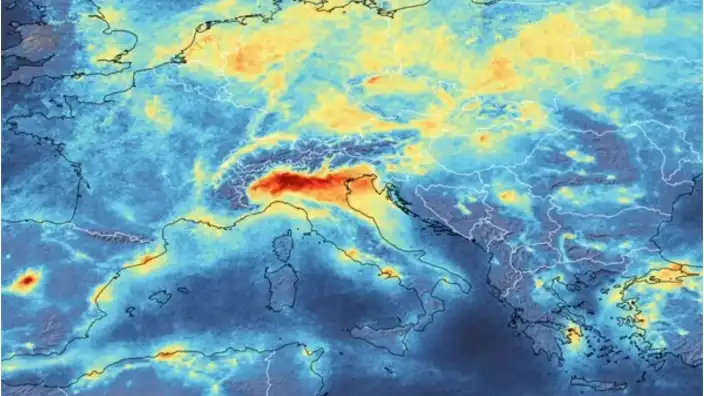
Updates
Regular updates on the situation (all sources referenced).
March 17, 2020 (I)
- The mortality profile remains puzzling from a virological point of view because, in contrast to influenza viruses, children are spared and men are affected about twice as often as women. On the other hand, this profile corresponds to natural mortality, which is close to zero for children and almost twice as high for 75-year-old men as for women of the same age.
- The younger test-positive deceased almost always had severe pre-existing conditions. For example, a 21-year-old Spanish soccer coach had died test-positive, making international headlines. However, the doctors diagnosed an unrecognized leukemia, whose typical complications include severe pneumonia.
- The decisive factor in assessing the danger of the disease is therefore not the number of test-positive persons and deceased, which is often mentioned in the media, but the number of people actually and unexpectedly developing or dying from pneumonia (so-called excess mortality). So far, this value remains very low in most countries.
- In Switzerland, some emergency units are already overloaded simply because of the large number of people who want to be tested. This points to an additional psychological and logistical component of the current situation.
March 17, 2020 (II)
- Italian immunology professor Sergio Romagnani from the University of Florence comes to the conclusion in a study on 3000 people that 50 to 75% of the test-positive people of all ages remain completely symptom-free – significantly more than previously assumed.
- The occupancy rate of the North Italian ICUs in the winter months is typically already 85 to 90%. Some or many of these existing patients could also be test-positive by now. However, the number of additional unexpected pneumonia cases is not yet known.
- A hospital doctor in the Spanish city of Malaga writes on Twitter that people are currently more likely to die from panic and systemic collapse than from the virus. The hospital is being overrun by people with colds, flu and possibly Covid19 and doctors have lost control.
March 18, 2020
- A new epidemiological study (preprint) concludes that the fatality of Covid19 even in the Chinese city of Wuhan was only 0.04% to 0.12% and thus rather lower than that of seasonal flu, which has a mortality rate of about 0.1%. As a reason for the overestimated fatality of Covid19, the researchers suspect that initially only a small number of cases were recorded in Wuhan, as the disease was probably asymptomatic or mild in many people.
- Chinese researchers argue that extreme winter smog in the city of Wuhan may have played a causal role in the outbreak of pneumonia. In the summer of 2019, public protests were already taking place in Wuhan because of the poor air quality.
- New satellite images show how Northern Italy has the highest levels of air pollution in Europe, and how this air pollution has been greatly reduced by the quarantine.
- A manufacturer of the Covid19 test kit states that it should only be used for research purposes and not for diagnostic applications, as it has not yet been clinically validated.

March 19, 2020 (I)
The Italian National Health Institute ISS has published a new report on test-positive deaths:
- The median age is 80.5 years (79.5 for men, 83.7 for women).
- 10% of the deceased was over 90 years old; 90% of the deceased was over 70 years old.
- At most 0.8% of the deceased had no pre-existing chronic illnesses.
- Approximately 75% of the deceased had two or more pre-existing conditions, 50% had three more pre-existing conditions, in particular heart disease, diabetes and cancer.
- Five of the deceased were between 31 and 39 years old, all of them with serious pre-existing health conditions (e.g. cancer or heart disease).
- The National Health Institute hasn’t yet determined what the patients examined ultimately died of and refers to them in general terms as Covid19-positive deaths.
March 19, 2020 (II)
- A report in the Italian newspaper Corriere della Sera points out that Italian intensive care units already collapsed under the marked flu wave in 2017/2018. They had to postpone operations, call nurses back from holiday and ran out of blood donations.
- German virologist Hendrik Streeck argues that Covid19 is unlikely to increase total mortality in Germany, which normally is around 2500 people per day. Streeck mentions the case of a 78-year-old man with preconditions who died of heart failure, subsequently tested positive for Covid19 and thus was included in the statistics of Covid19 deaths.
- According to Stanford Professor John Ioannidis, the new coronavirus may be no more dangerous than some of the common coronaviruses, even in older people. Ioannidis argues that there is no reliable medical data backing the measures currently decided upon.
March 20, 2020
- According to the latest European monitoring report, overall mortality in all countries (including Italy) and in all age groups remains within or even below the normal range so far.
- According to the latest German statistics, the median age of test-positive deaths is about 83 years, most with pre-existing health conditions that might be a possible cause of death.
- A 2006 Canadian study referred to by Stanford Professor John Ioannidis found that common cold coronaviruses may also cause death rates of up to 6% in risk groups such as residents of a care facility, and that virus test kits initially falsely indicated an infection with SARS coronaviruses.
March 21, 2020 (I)
- Spain reports only three test-positive deaths under the age of 65 (out of a total of about 1000). Their pre-existing health conditions and actual cause of death are not yet known.
- On March 20, Italy reported 627 nationwide test-positive deaths in one day. By comparison, normal overall mortality in Italy is about 1800 deaths per day. Since February 21, Italy has reported about 4000 test-positive deaths. Normal overall mortality during this time frame is up to 50,000 deaths. It is not yet known to what extent normal overall mortality has increased, or to what extent it has simply turned test-positive. Moreover, Italy and Europe have had a very mild flu season in 2019/2020 that has spared many otherwise vulnerable people.
- According to Italian news reports, 90% of test-positive deceased in the Lombardy region have died outside of intensive care units, mostly at home or in general care sections. Their cause of death and the possible role of quarantine measures in their deaths remain unclear. Only 260 out of 2168 test-positive persons have died in ICUs.
- Bloomberg highlights that „99% of Those Who Died From Virus Had Other Illness, Italy Says“
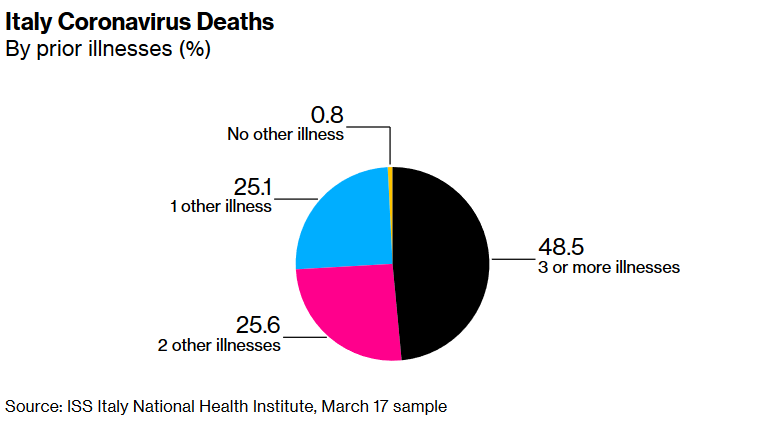
March 21, 2020 (II)
- The Japan Times asks: Japan was expecting a coronavirus explosion. Where is it? Despite being one of the first countries getting positive test results and having imposed no lockdown, Japan is one of the least-affected nations. Quote: „Even if Japan may not be counting all those infected, hospitals aren’t being stretched thin and there has been no spike in pneumonia cases.“
- Italian researchers argue that the extreme smog in Northern Italy, the worst in Europe, may be playing a causative role in the current pneumonia outbreak there, as in Wuhan before.
- In a new interview, Professor Sucharit Bhakdi, a world renowned expert in medical microbiology, says blaming the new coronavirus alone for deaths is „wrong“ and „dangerously misleading“, as there are other more important factors at play, notably pre-existing health conditions and poor air quality in Chinese and Northern Italian cities. Professor Bhakdi describes the currently discussed or imposed measures as „grotesque“, „useless“, „self-destructive“ and a „collective suicide“ that will shorten the lifespan of the elderly and should not be accepted by society.
March 22, 2020 (I)
Regarding the situation in Italy: Most major media falsely report that Italy has up to 800 deaths per day from the coronavirus. In reality, the president of the Italian Civil Protection Service stresses that these are deaths „with the coronavirus and not from the coronavirus“ (minute 03:30 of the press conference). In other words, these persons died while also testing positive.
As Professors Ioannidis and Bhakdi have shown, countries like South Korea and Japan that introduced no lockdown measures have experienced near-zero excess mortality in connection with Covid-19, while the Diamond Princess cruise ship experienced an extrapolated mortality figure in the per mille range, i.e. at or below the level of the seasonal flu.
Current test-positive death figures in Italy are still less than 50% of normal daily overall mortality in Italy, which is around 1800 deaths per day. Thus it is possible, perhaps even likely, that a large part of normal daily mortality now simply counts as „Covid19“ deaths (as they test positive). This is the point stressed by the President of the Italian Civil Protection Service.
However, by now it is clear that certain regions in Northern Italy, i.e. those facing the toughest lockdown measures, are experiencing markedly increased daily mortality figures. It is also known that in the Lombardy region, 90% of test-positive deaths occur not in intensive care units, but instead mostly at home. And more than 99% have serious pre-existing health conditions.
Professor Sucharit Bhakdi has called lockdown measures „useless“, „self-destructive“ and a „collective suicide“. Thus the extremely troubling question arises as to what extent the increased mortality of these elderly, isolated, highly stressed people with multiple pre-existing health conditions may in fact be caused by the weeks-long lockdown measures still in force.
If so, it may be one of those cases where the treatment is worse than the disease. (See update below: only 12% of death certificates show the coronavirus as a cause.)
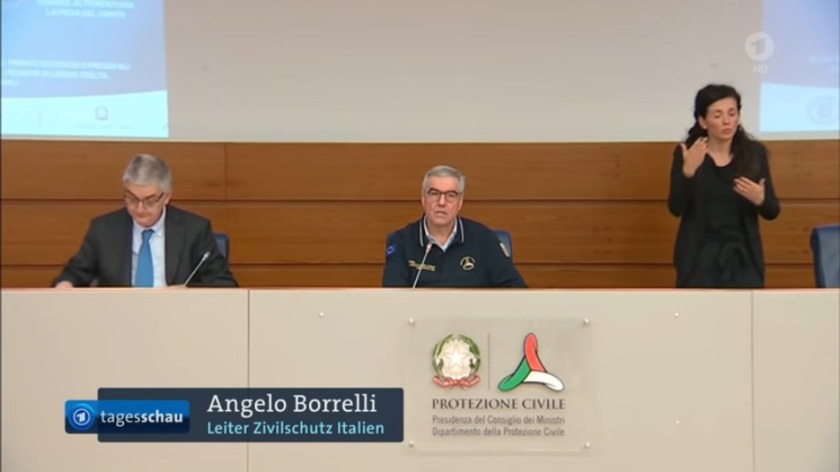
March 22, 2020 (II)
- In Switzerland, there are currently 56 test-positive deaths, all of whom were „high risk patients“ due to their advanced age and/or pre-existing health conditions. Their actual cause of death, i.e. from or simply with the virus, has not been communicated.
- The Swiss government claimed that the situation in southern Switzerland (next to Italy) is „dramatic“, yet local doctors denied this and said everything is normal.
- According to press reports, oxygen bottles may become scarce. The reason, however, is not a currently higher usage, but rather hoarding due to fear of future shortages.
- In many countries, there is already an increasing shortage of doctors and nurses. This is primarily because healthcare workers testing positive have to self-quarantine, even though in many cases they will remain fully or largely symptom-free.
March 22, 2020 (III)
- A model from Imperial College London predicted between 250,000 and 500,000 deaths in the UK „from“ Covid-19, but the authors of the study have now conceded that many of these deaths would not be in addition to, but rather part of the normal annual mortality rate, which in the UK is about 600,000 people per year. In other words, excess mortality would remain low.
- Dr. David Katz, founding director of the Yale University Prevention Research Center, asks in the New York Times: „Is Our Fight Against Coronavirus Worse Than the Disease? There may be more targeted ways to beat the pandemic.“
- According to Italian Professor Walter Ricciardi, „only 12% of death certificates have shown a direct causality from coronavirus“, whereas in public reports „all the people who die in hospitals with the coronavirus are deemed to be dying of the coronavirus“. This means that Italian death figures reported by the media have to be reduced by at least a factor of 8 to obtain actual deaths caused by the virus. Thus one ends up with at most a few dozen deaths per day, compared to an overall daily mortality of 1800 deaths and up to 20,000 flu deaths per year.
March 23, 2020 (I)
- A new French study in the Journal of Antimicrobial Agents, titled SARS-CoV-2: fear versus data, concludes that „the problem of SARS-CoV-2 is probably overestimated“, since „the mortality rate for SARS-CoV-2 is not significantly different from that for common coronaviruses identified at the study hospital in France“.
- An Italian study of August 2019 found that flu deaths in Italy were between 7,000 and 25,000 in recent years. This value is higher than in most other European countries due to the large elderly population in Italy, and much higher than anything attributed to Covid-19 so far.
- In a new fact sheet, the World Health Organization WHO reports that Covid-19 is in fact spreading slower, not faster, than influenza by a factor of about 50%. Moreover, pre-symptomatic transmission appears to be much lower with Covid-19 than with influenza.
- A leading Italian doctor reports that „strange cases of pneumonia“ were seen in the Lombardy region already in November 2019, raising again the question if they were caused by the new virus (which officially only appeared in Italy in February 2020), or by other factors, such as the dangerously high smog levels in Northern Italy.
- Danish researcher Peter Gøtzsche, founder of the renowned Cochrane Medical Collaboration, writes that Corona is „an epidemic of mass panic“ and „logic was one of the first victims.“
March 23, 2020 (II)
- Former Israeli Health Minister, Professor Yoram Lass, says that the new coronavirus is „less dangerous than the flu“ and lockdown measures „will kill more people than the virus“. He adds that „the numbers do not match the panic“ and „psychology is prevailing over science“. He also notes that „Italy is known for its enormous morbidity in respiratory problems, more than three times any other European country.“
- Pietro Vernazza, a Swiss infectious disease specialist, argues that many of the imposed measures are not based on science and should be reversed. According to Vernazza, mass testing makes no sense because 90% of the population will see no symptoms, and lockdowns and closing schools are even „counterproductive“. He recommends protecting only risk groups while keeping the economy and society at large undisturbed.
- The President of the World Doctors Federation, Frank Ulrich Montgomery, argues that lockdown measures as in Italy are „unreasonable“ and „counterproductive“ and should be reversed.
- In Switzerland, despite media panic, excess mortality is still at or near zero: the latest test-positive „victims“ were a 96-year-old in palliative care and a 97-year-old with pre-existing conditions.
- The latest statistical report of the Italian National Health Institute is now available in English.
March 24, 2020
- The UK has removed Covid19 from the official list of High Consquence Infectious Diseases (HCID), stating that mortality rates are „low overall“.
- The director of the German National Health Institute (RKI) admitted that they count all test-positive deaths, irrespective of the actual cause of death, as „coronavirus deaths“. The average age of the deceased is 82 years, most with serious preconditions. As in most other countries, excess mortality due Covid19 is likely to be near zero in Germany.
- Beds in Swiss intensive care units reserved for Covid19 patients are still „mostly empty“.
- German Professor Karin Moelling, former Chair of Medical Virology at the University of Zurich, stated in an interview that Covid19 is „no killer virus“ and that „panic must end“.
March 25, 2020
- German immunologist and toxicologist, Professor Stefan Hockertz, explains in a radio interview that Covid19 is no more dangerous than influenza (the flu), but that it is simply observed much more closely. More dangerous than the virus is the fear and panic created by the media and the „authoritarian reaction“ of many governments. Professor Hockertz also notes that most so-called „corona deaths“ have in fact died of other causes while also testing positive for coronaviruses. Hockertz believes that up to ten times more people than reported already had Covid19 but noticed nothing or very little.
- The Argentinean virologist and biochemist Pablo Goldschmidt explains that Covid19 is no more dangerous than a bad cold or the flu. It is even possible that the Covid19 virus circulated already in earlier years, but wasn’t discovered because no one was looking for it. Dr. Goldschmidt speaks of a „global terror“ created by the media and politics. Every year, he says, three million newborns worldwide and 50,000 adults in the US alone die of pneumonia.
- Professor Martin Exner, head of the Institute for Hygiene at the University of Bonn, explains in an interview why health personnel are currently under pressure, even though there has hardly been any increase in the number of patients in Germany so far: On the one hand, doctors and nurses who have tested positive have to be quarantined and are often hard to replace. On the other hand, nurses from neighbouring countries, who provide an important part of the care, are currently unable to enter the country due to closed borders.
- Professor Julian Nida-Ruemelin, former German Minister of State for Culture and Professor of Ethics, points out that Covid19 poses no risk to the healthy general population and that extreme measures such as curfews are therefore not justified.
- Using data from the cruise ship Diamond Princess, Stanford Professor John Ioannidis showed that the age-corrected lethality of Covid19 is between 0.025% and 0.625%, i.e. in the range of a strong cold or the flu. Moreover, a Japanese study showed that of all the test-positive passengers, and despite the high average age, 48% remained completely symptom-free; even among the 80-89 year olds 48% remained symptom-free, while among the 70 to 79 year olds it was an astounding 60% that developed no symptoms at all. This again raises the question whether the pre-existing diseases are not perhaps a more important factor than the virus itself. The Italian example has shown that 99% of test-positive deaths had one or more pre-existing conditions, and even among these, only 12% of the death certificates mentioned Covid19 as a causal factor.
March 26, 2020 (I)
- USA: The latest US data of March 25 shows a decreasing number of flu-like illnesses throughout the country, the frequency of which is now well below the multi-year average. The government measures can be ruled out as a reason for this, as they have been in effect for less than a week.
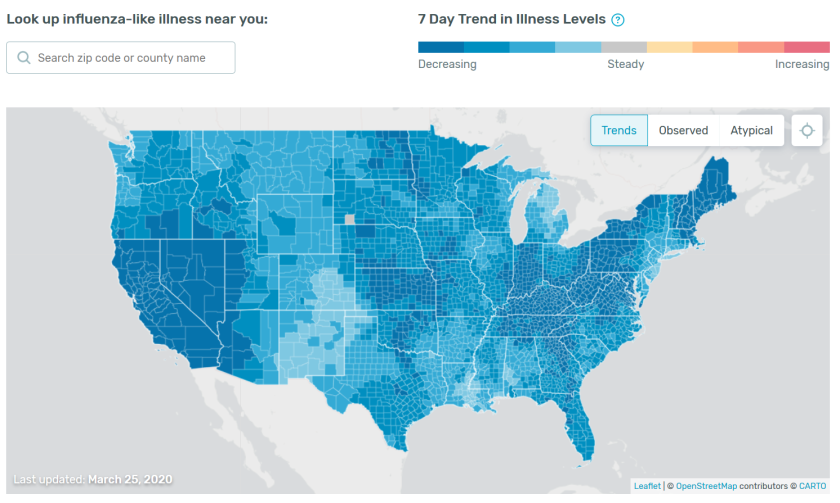
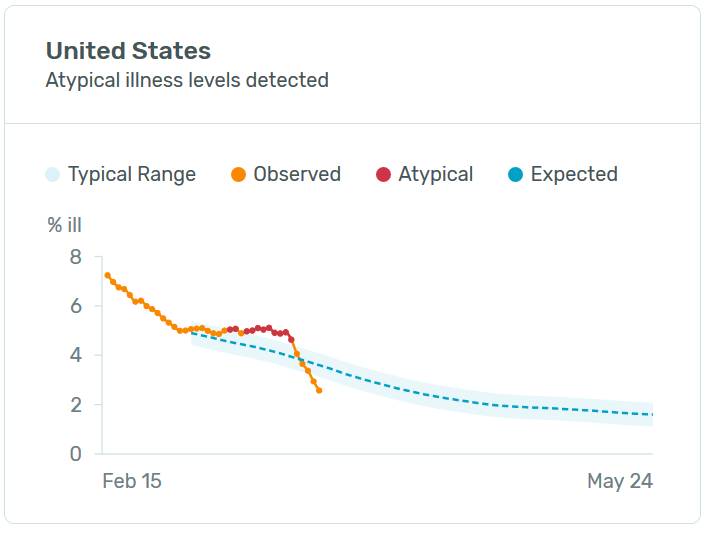
USA: Decreasing flu-like illnesses (March 25, 2020, KINSA)
- Germany: The latest influenza report of the German Robert Koch Institute of March 24 documents a „nationwide decrease in activity of acute respiratory diseases“: The number of influenza-like illnesses and the number of hospital stays caused by them is below the level of previous years and is currently continuing to decline. The RKI continues: „The increase in the number of visits to the doctor cannot currently be explained either by influenza viruses circulating in the population or by SARS-CoV-2.“
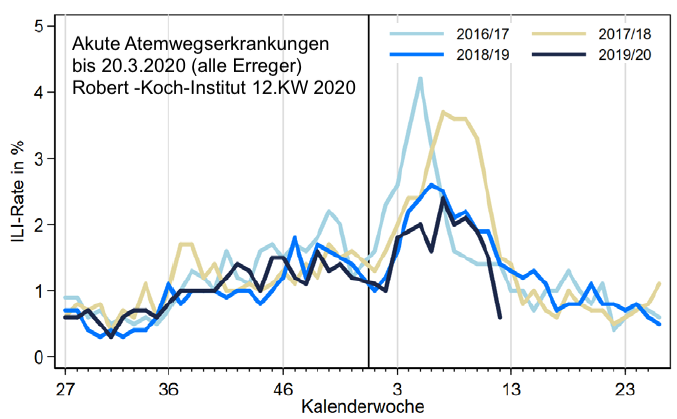
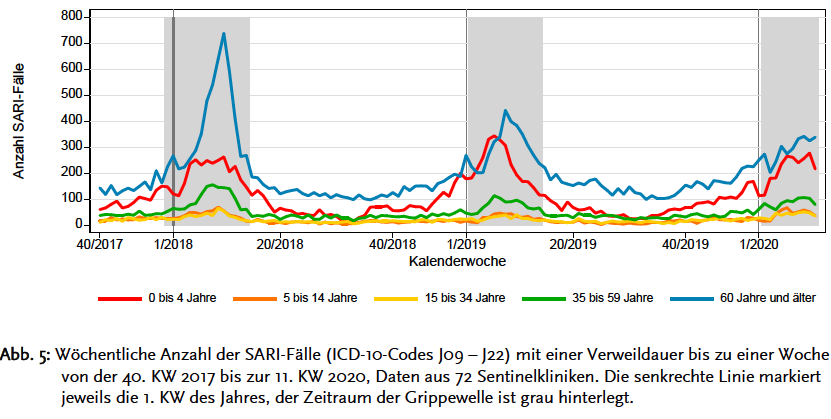
Germany: Decreasing flu-like illnesses (20 March 2020, RKI)
- Italy: The renowned Italian virologist Giulio Tarro argues that the mortality rate of Covid19 is below 1% even in Italy and is therefore comparable to influenza. The higher values only arise because no distinction is made between deaths with and by Covid19 and because the number of (symptom-free) infected persons is greatly underestimated.
- UK: The authors of the British Imperial College study, who predicted up to 500,000 deaths, are again reducing their forecasts. After already admitting that a large proportion of test-positive deaths are part of normal mortality, they now state that the peak of the disease may be reached in two to three weeks already.
- UK: The British Guardian reported in February 2019 that even in the generally weak flu season 2018/2019 there were more than 2180 flu-related admissions to intensive care units in the UK.
- Switzerland: In Switzerland, the excess mortality due to Covid19 is apparently still zero. The latest „fatal victim“ presented by the media is a 100-year-old woman. Nevertheless, the Swiss government continues to tighten restrictive measures.
March 26, 2020 (II)
- Sweden: Sweden has so far pursued the most liberal strategy in dealing with Covid19, which is based on two principles: Risk groups are protected and people with flu symptoms stay at home. „If you follow these two rules, there is no need for further measures, the effect of which is only marginal anyway,“ said chief epidemiologist Anders Tegnell. Social and economic life will continue normally. The big rush to hospitals has so far failed to materialize, Tegnell said.
- German criminal and constitutional law expert Dr. Jessica Hamed argues that measures such as general curfews and contact bans are a massive and disproportionate encroachment on fundamental rights of freedom and are therefore presumably „all illegal“.
- The latest European monitoring report on overall mortality continues to show normal or below-average values in all countries and all age groups, but now with one exception: in the 65+ age group in Italy a currently increased overall mortality is predicted (so-called delay-adjusted z-score), which is, however, still below the values of the influenza waves of 2017 and 2018.
March 27, 2020 (I)
Italy: According to the latest data published by the Italian Ministry of Health, overall mortality is now significantly higher in all age groups over 65 years of age, after having been below average due to the mild winter. Until March 14, overall mortality was still below the flu season of 2016/2017, but may have already exceeded it in the meantime. Most of this excess mortality currently comes from northern Italy. However, the exact role of Covid19, compared to other factors such as panic, healthcare collapse and the lockdown itself, is not yet clear.
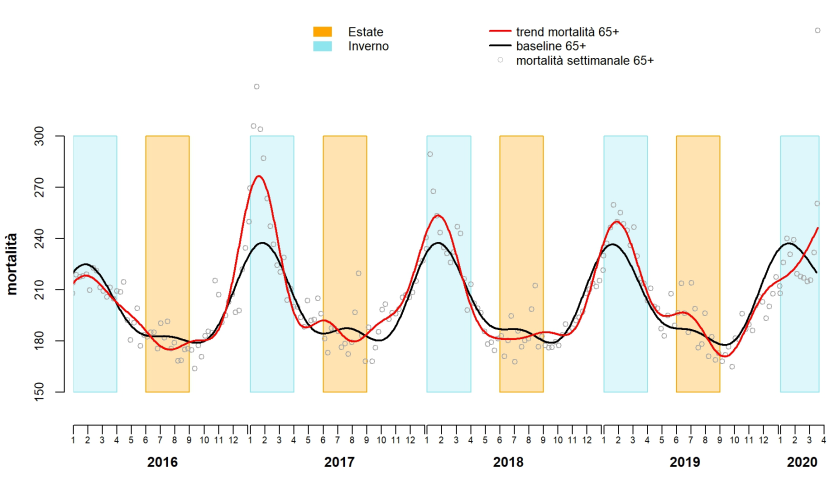
France: According to the latest data from France, overall mortality at the national level remains within the normal range after a mild influenza season. However, in some regions, particularly in the north-east of France, overall mortality in the over-65 age group has already risen sharply in connection with Covid19 (see figure below).

France also provides detailed information on the age distribution and pre-existing conditions of test-positive intensive care patients and deceased patients (see figure below):
- The average age of the deceased is 81.2 years.
- 78% of the deceased were over 75 years old; 93% were over 65 years old.
- 2.4% of the deceased were under 65 years of age and had no (known) previous illness
- The average age of intensive care patients is 65 years.
- 26% of intensive care patients are over 75 years old; 67% have previous illnesses.
- 17% of intensive care patients are under 65 years of age and have no previous illnesses.
The French authorities add that „the share of the (Covid-19) epidemic in overall mortality remains to be determined.“

USA: Researcher Stephen McIntyre has evaluated the official data on deaths from pneumonia in the US. There are usually between 3000 and 5500 deaths per week and thus significantly more than the current figures for Covid19. The total number of deaths in the US is between 50,000 and 60,000 per week. (Note: In the graph below, the latest figures for March 2020 have not yet been fully updated, so the curve is slumping).
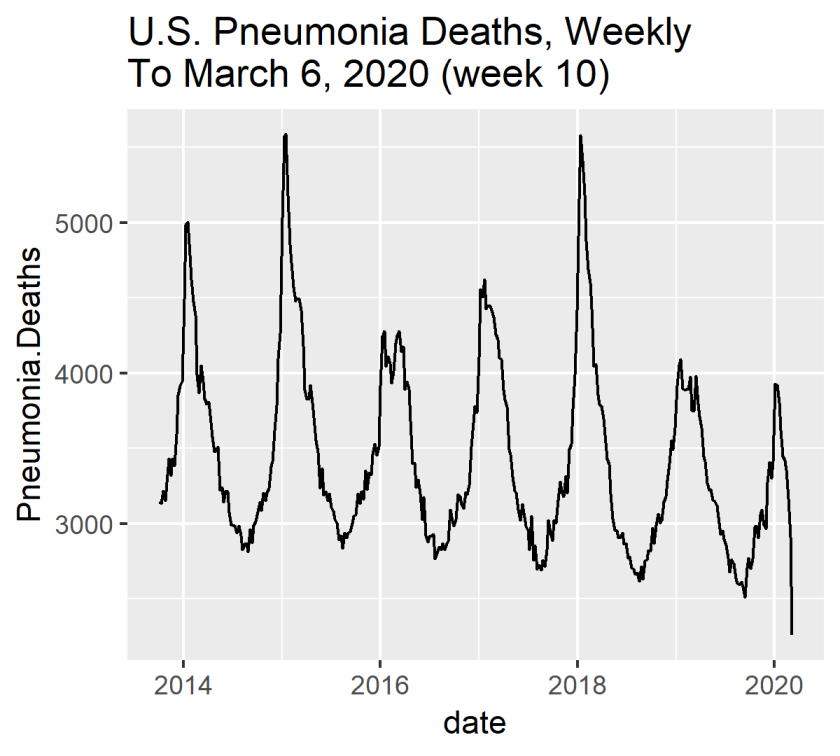
Great Britain:
- Neil Ferguson of Imperial College London now assumes that the UK has sufficient capacity in intensive care units to treat Covid19 patients.
- John Lee, Professor Emeritus of Pathology, argues that the particular way in which Covid-19 cases are registered leads to an overestimation of the risk posed by Covid19 compared to normal flu and cold cases.
Other topics:
- A preliminary study by researchers at Stanford University showed that 20 to 25% of Covid19-positive patients tested additionally positive for other influenza or cold viruses.
- The number of applications for unemployment insurance in the US skyrocketed to a record of over three million. In this context, a sharp increase in suicides is also expected.
- The first test-positive patient in Germany has now recovered. According to his own statement, the 33-year-old man had experienced the illness „not as bad as the flu“.
- Spanish media report that the antibody rapid tests for Covid19 only have a sensitivity of 30%, although it should be at least 80%.
- A study from China in 2003 concluded that the probability of dying from SARS is 84% higher in people exposed to moderate air pollution than in patients from regions with clean air. The risk is even 200% higher among people from areas with heavily polluted air.
- The German Network for Evidence-Based Medicine (EbM) criticises the media reporting on Covid19: „The media coverage does not in any way take into account the criteria of evidence-based risk communication that we have demanded. () The presentation of raw data without reference to other causes of death leads to an overestimation of the risk“.
March 27, 2020 (II)
- German researcher Dr. Richard Capek argues in a quantitative analysis that the „Corona epidemic“ is in fact an „epidemic of tests“. Capek shows that while the number of tests has increased exponentially, the proportion of infections has remained stable and mortality has decreased, which speaks against an exponential spread of the virus itself (see below).
- German Virology professor Dr. Carsten Scheller from the University of Würzburg explains in a podcast that Covid19 is definitely comparable with influenza and has so far even led to fewer deaths. Professor Scheller suspects that the exponential curves often presented in the media have more to do with the increasing number of tests than with an unusual spread of the virus itself. For countries like Germany, Italy is less of a role model than Japan and South Korea. Despite millions of Chinese tourists and only minimal social restrictions, these countries have not yet experienced a Covid19 crisis. One reason for this could be the wearing of mouth masks: This would hardly protect against infection, but would limit the spread of the virus by infected people.
- The latest figures from Bergamo (city) show that total mortality in March 2020 increased from typically 150 people per month to around 450 people. It is still unclear what proportion of this was due to Covid19 and what proportion was due to other factors such as mass panic, systemic collapse and the lockdown itself. Apparently the city hospital was overrun by people from the whole region and collapsed.
- The two Stanford professors of medicine, Dr. Eran Bendavid and Dr. Jay Bhattacharya, explain in an article that the lethality of Covid19 is overestimated by several orders of magnitude and is probably even in Italy only at 0.01% to 0.06% and thus below that of influenza. The reason for this overestimation is the greatly underestimated number of people already infected (without symptoms). As an example, the fully tested Italian community of Vo is mentioned, which showed 50 to 75% symptom-free test-positive persons.
- Dr. Gerald Gaß, President of the German Hospital Association, explained in an interview with the Handelsblatt that „the extreme situation in Italy is mainly due to the very low intensive care capacities“.
- Dr. Wolfgang Wodarg, one of the early and vocal critics of a „Covid19 panic“, was provisionally excluded by the board of Transparency Internantional Germany, where he headed the health working group. Wodarg had already been severely attacked by the media for his criticism.
- NSA whistleblower Edward Snowden warns that governments are using the current situation to expand the surveillance state and restrict fundamental rights. The control measures currently put in place would not be dismantled after the crisis.
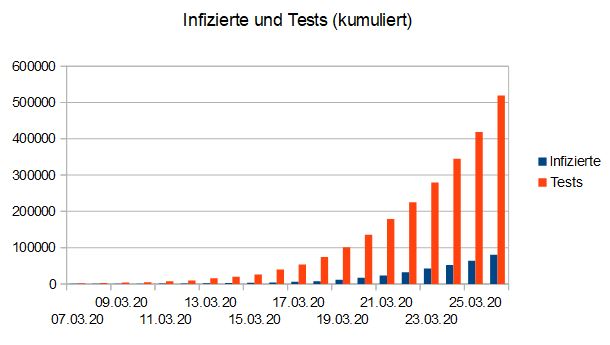
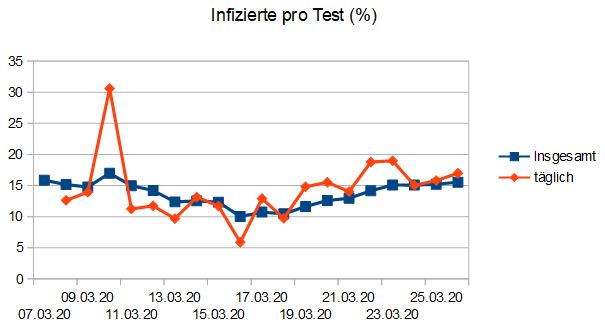
The increasing number of tests is finding a proportional number of infections, the ratio stays constant, speaking against an ongoing viral epidemic (Dr. Richard Capek, US data)
March 28, 2020
- A new study by the University of Oxford concludes that Covid19 may already have existed in the UK since January 2020 and that half of the population may already be immunised, with most people experiencing no or only mild symptoms. This would mean that only one in a thousand people would need to be hospitalised for Covid19. (Study)
- British media reported on a 21 year old woman „who died of Covid19 without any previous illnesses“. However, it has since become known that the woman did not test positive for Covid19 and died of a heart failure. The Covid19 rumor had arisen „because she had a slight cough“.
- The German media scientist Professor Otfried Jarren criticized that many media provide uncritical journalism that emphasizes threats and executive power. According to Professor Jarren, there is hardly any differentiation and real debate between experts.
March 29, 2020
- Dr Sucharit Bhakdi, Professor Emeritus of Medical Microbiology in Mainz, Germany, wrote an Open Letter to German Chancellor Dr Angela Merkel, calling for an urgent reassessment of the response to Covid19 and asking the Chancellor five crucial questions.
- The latest data from the German Robert Koch Institute show that the increase in test-positive persons is proportional to the increase in the number of tests, i.e. in percentage terms it remains roughly the same. This may indicate that the increase in the number of cases is mainly due to an increase in the number of tests, and not due to an ongoing epidemic.
- The Milan microbiologist Maria Rita Gismondo calls on the Italian government to stop communicating the daily number of „corona positives“ as these figures are „fake“ and put the population in unnecessary panic. The number of test-positives depends very much on the type and number of tests and says nothing about the state of health.
- Dr. John Ioannidis, Stanford Professor of Medicine and Epidemiology, gave an in-depth one-hour interview on the lack of data for Covid19 measures.
- The Argentinean virologist Pablo Goldschmidt, who lives in France, considers the political reaction to Covid19 as „completely exaggerated“ and warns against „totalitarian measures“. In parts of France, the movement of people is already monitored by drones.
- Italian author Fulvio Grimaldi, born in 1934, explains that the state measures currently implemented in Italy are „worse than under fascism“. Parliament and society have been completely disempowered.
March 30, 2020 (I)
- In Germany, some clinics can no longer accept patients – not because there are too many patients or too few beds, but because the nursing staff have tested positive, although in most cases they hardly show any symptoms. This case illustrates again how and why health care systems are getting paralysed.
- In a German retirement and nursing home for people with advanced dementia, 15 test-positive people have died. However, „surprisingly many people have died without showing symptoms of corona.“ A German medical specialist informs us: „From my medical point of view, there is some evidence that some of these people may have died as a result of the measures taken. People with dementia get into high stress when major changes are made to their everyday lives: isolation, no physical contact, possibly hooded staff.“ Nevertheless, the deceased are counted as „corona deaths“ in German and international statistics. In connection with the „corona crisis“, it is now also possible to die of an illness without even having its symptoms.
- According to a Swiss pharmacologist, the Swiss Inselspital in Bern has forced staff to take leave, stopped therapies and postponed operations due to the fear of Covid19.
- Professor Gérard Krause, head of the Department of Epidemiology at the German Helmholtz Centre for Infection Research, warns on German public television ZDF that the anti-corona measures „could lead to more deaths than the virus itself„.
- Various media reported that more than 50 doctors in Italy have already died „during the corona crisis“, like soldiers in a battle. A glance at the corresponding list, however, shows that most of the deceased are retired doctors of various kinds, including 90-year-old psychiatrists and pediatricians, many of whom may have died of natural causes.
- An extensive survey in Iceland found that 50% of all test-positive persons showed „no symptoms“ at all, while the other 50% mostly showed „very moderate cold-like symptoms“. According to the Icelandic data, the mortality rate of Covid19 is in the per mille range, i.e. in the flu range or below. Of the two test-positive deaths, one was „a tourist with unusual symptoms“. (More Icelandic data)
- The British Daily Mail journalist Peter Hitchens writes, „There’s powerful evidence this great panic is foolish. Yet our freedom is still broken and our economy crippled.“ Hitchens points out that in parts of the UK, police drones monitor and report „non-essential“ walks in nature. In some cases, police drones are calling on people via loudspeaker to go home in order to „save lives“. (Note: Not even George Orwell had thought that far ahead.)
- The Italian secret service warns of social unrest and uprisings. Supermarkets are already being looted and pharmacies raided.
- Professor Sucharit Bhakdi has meanwhile published a video (German/English) in which he explains his Open Letter to German Chancellor Dr. Angela Merkel.
March 30, 2020 (II)
In several countries, there is increasing evidence in relation to Covid19 that „the treatment could be worse than the disease“.
On the one hand, there is the risk of so-called nosocomial infections, i.e. infections that the patient, who may only be mildly ill, acquires in hospital. It is estimated that there are approximately 2.5 million nosocomial infections and 50,000 deaths per year in Europe. Even in German intensive care units, about 15% of patients acquire a nosocomial infection, including pneumonia on artificial respiration. There is also the problem of increasingly antibiotic-resistant germs in hospitals.
Another aspect is the certainly well-intentioned but sometimes very aggressive treatment methods that are increasingly used in Covid19 patients. These include, in particular, the administration of steroids, antibiotics and anti-viral drugs (or a combination thereof). Already in the treatment of SARS-1 patients, it has been shown that the outcome with such treatment was often worse and more fatal than without such treatment.
March 31, 2020 (I)
Dr. Richard Capek and other researchers have already shown that the number of test-positive individuals in relation to the number of tests performed remains constant in all countries studied so far, which speaks against an exponential spread („epidemic“) of the virus and merely indicates an exponential increase in the number of tests.
Depending on the country, the proportion of test-positive individuals is between 5 and 15%, which corresponds to the usual spread of corona viruses. Interestingly, these constant numerical values are not actively communicated (or even removed) by authorities and the media. Instead, exponential but irrelevant and misleading curves are shown without context.
Such behavior, of course, does not correspond to professional medical standards, as a look at the traditional influenza report of the German Robert Koch Institute makes clear (p. 30, see chart below). Here, in addition to the number of detections (right), the number of samples (left, grey bars) and the positive rate (left, blue curve) are shown.
This immediately shows that during a flu season the positive rate rises from 0 to 10% to up to 80% of the samples and drops back to the normal value after a few weeks. In comparison, Covid19 tests show a constant positive rate in the normal range (see below).

Constant Covid19-positive rate using US data (Dr. Richard Capek). This applies analogously to all other countries for which data on the number of samples is currently available.

March 31, 2020 (II)
- A graphical analysis of the European monitoring data impressively shows that, irrespective of the measures taken, overall mortality throughout Europe remained in the normal range or below by March 25, and often significantly below the levels of previous years. Only in Italy (65+) was the overall mortality rate somewhat increased (probably for several reasons), but it was still below previous flu seasons.
- The president of the German Robert Koch Institute confirmed again that pre-existing conditions and actual cause of death do not play a role in the definition of so-called „corona deaths“. From a medical point of view, such a definition is clearly misleading. It has the obvious and generally known effect of putting politics and society in fear.
- In Italy the situation is now beginning to calm down. As far as is known, the temporarily increased mortality rates (65+) were rather local effects, often accompanied by mass panic and a breakdown in health care. A politician from northern Italy asks, for example, „how is it possible that Covid patients from Brescia are transported to Germany, while in the nearby Verona two thirds of intensive care beds are empty?“
- In an article published in the European Journal of Clinical Investigation, Stanford professor of medicine John C. Ioannidis criticizes the „harms of exaggerated information and non-evidence-based measures“. Even journals had published dubious claims at the beginning.
- A Chinese study published in the Chinese Journal of Epidemiology in early March, which indicated the unreliability of the Covid19 virus tests (approx. 50% false-positive results in asymptomatic patients), has since been withdrawn. The lead author of the study, the dean of a medical school, did not want to give the reason for the withdrawal and spoke of a „sensitive matter„, which could indicate political pressure, as an NPR journalist noted. Independent of this study, however, the unreliability of so-called PCR virus tests has long been known: In 2006, for example, a mass infection in a Canadian nursing home with SARS corona viruses was „found“, which later turned out to be common cold corona viruses (which can also be fatal for risk groups).
- Authors of the German Risk Management Network RiskNET speak in a Covid19 analysis of a „blind flight“ as well as „insufficient data competence and data ethics“. Instead of more and more tests and measures a representative sample is necessary. The „sense and ratio“ of the measures must be critically questioned.
- The Spanish interview with the internationally renowned Argentinian-French virologist Pablo Goldschmidt was translated into German. Goldschmidt considers the measures imposed to be medically counterproductive and notes that one must now „read Hannah Arendt“ to understand the „origins of totalitarianism“.
- Hungarian Prime Minister Viktor Orban, like other prime ministers and presidents before him, has largely disempowered the Hungarian parliament under an „emergency law“ and can now govern essentially by decree.

„The only means to fight the plague is honesty.“
Albert Camus, The Plague (1947)
Related articles
Share this on: Twitter / Facebook
